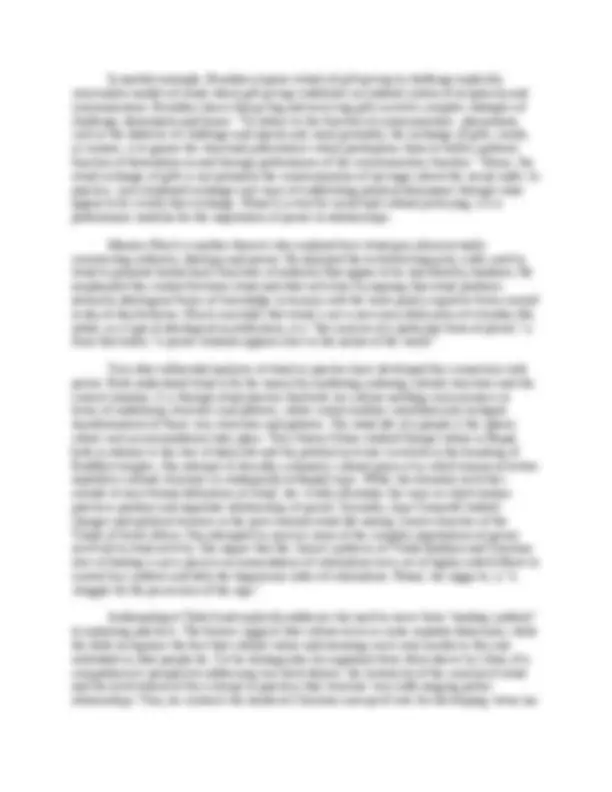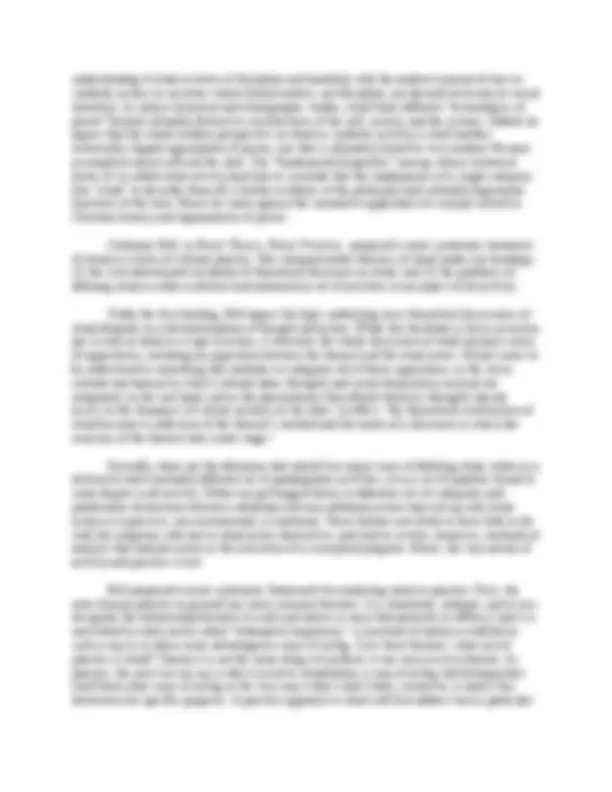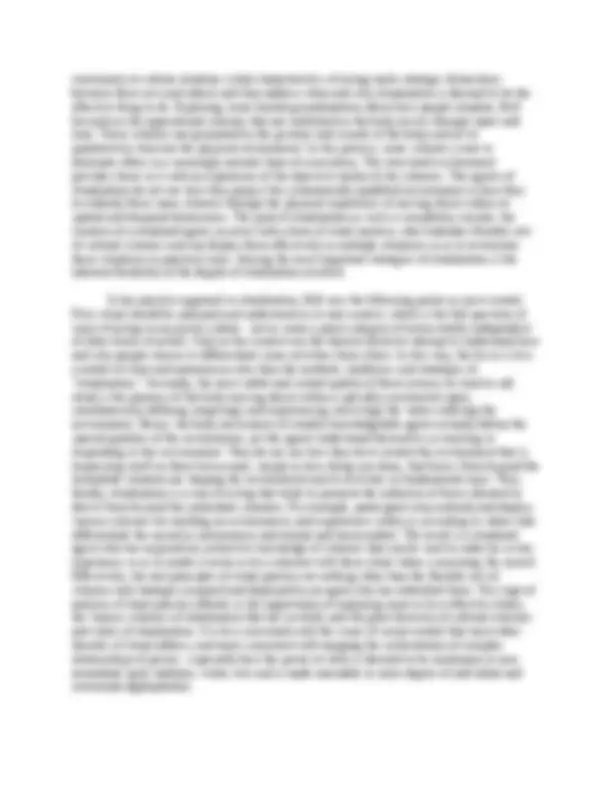





Study with the several resources on Docsity

Earn points by helping other students or get them with a premium plan


Prepare for your exams
Study with the several resources on Docsity

Earn points to download
Earn points by helping other students or get them with a premium plan
Community
Ask the community for help and clear up your study doubts
Discover the best universities in your country according to Docsity users
Free resources
Download our free guides on studying techniques, anxiety management strategies, and thesis advice from Docsity tutors
The emergence of practice theory in the 1970s as a response to performance theory, with a focus on the analysis of ritual as a form of human practice. Practice theories share concerns with performance theory, particularly the critique of purely structural or semiotic approaches to cultural analysis. They claim to take seriously the way that human activities, including formal religious rituals and casual recreational activities, are creative strategies for reproducing and reshaping social and cultural environments. The political dimensions of social relationships and the lingering effects of colonialism and economic and cultural domination. Two prominent theorists, marshall sahlins and pierre bourdieu, are examined for their perspectives on ritual as a means of mediating enduring cultural structures and the current situation, and for their insights into the role of human action in shaping culture and history.
Typology: Study notes
1 / 6

This page cannot be seen from the preview
Don't miss anything!




S/A 4074: Ritual and Ceremony Lecture 17:Ritual and Practice Beyond performance theory, the 1970's saw the emergence of several formulations of human action as praxis or “practice,” a term that has usurped structure as the dominant image for cultural analysis. Practice theories share a number of concerns with performance theory, particularly the critique of purely structural or semiotic approaches to account for historical change, action as action, and acting individuals as bodies and not just minds. Contrasting with the static view of structuralism (which tends to see human activity as enacting cultural rules), practice theory claims to take seriously the way that human activities, whether formal religious ritual or casual recreational activities, are creative strategies by which humans continually reproduce and reshape their social and cultural environments. Practice theory also deals with issues that differentiate it from performance theory. Thus, it is less interested in specific types of acts, such as ritual or dance, and more in how cultural activity in general works. Still, some do address ritual and cast it as “paradigmatic” activity, activity that particularly showcases cultural patterns. Many are concerned with analyzing large processes of historical and cultural change, often developing models of the interaction of human action, needs and experiences, on one hand, with traditional cultural structures, organizational patterns, and symbolic systems, on the other. Secondly, practice theorists are particularly interested in the political dimensions of social relationships, especially with how patterns of domination and subordination are variously constituted, manipulated, or resisted. Indeed, practice theory emerged together with greater attention to the lingering effects of colonialism, the political ramifications of cross-cultural encounters, and the various effects of economic and cultural domination. In several highly theoretical ethnographic studies, Marshall Sahlins developed a provocative model of the cultural practices involved in ritual activity. He argued that practice brings together structure and history, system and event, continuity and change. Thus ritual enables enduring patterns of social organization while cultural symbolic systems can be brought to bear on real events. In the meantime, real situations are assessed and negotiated in ways that can transform these traditional patterns or structures in turn. For Sahlins, human action is critical in the shaping of culture and history, and he has sought the theoretical tools that can display this. One of his ethnographies discusses the death of explorer Captain James Cook at the hands of Hawaiians who, he claims, mistook Cook as one of their more important gods. Sahlins argues that Cook’s death resulted from his transgressions of the ritual status the Hawaiians had accorded him. Killing him was an active response to a cosmological crisis and not the mere reproduction of prescriptive rules or structures. As such, it was an act of performative tradition, or practice, and thus the very creation of history. For Sahlins, the traditional formality and self-consciousness of ritual make it a type of human practice in which basic cultural processes are particularly accessible to observation and analysis. Also, in some societies dominated by traditional forms of kingship, ritual activities appear central to cultural life in general. Hence, ritual can serve as a convenient example of the forces shaping all forms of social action. Sahlins tries to show how ritual creates a meaningful
event out of a new and potentially incomprehensible situation, namely by bringing traditional structures to bear on it. If done effectively, ritual action enables those structures to embrace and subdue the new situation, rendering it meaningful and enabling the structures themselves to continue to thrive as legitimate, appropriate, and relatively unaltered. If a situation resists the ritual formulas brought in to interpret it - if someone is hailed as a king but does not act like one
understanding if ritual in terms of discipline and morality) with the modern concept of rites as symbolic action (in societies where formal matters, not discipline, are deemed necessary to social morality). In various historical and ethnographic studies, Asad finds different “technologies of power” behind culturally distinctive constructions of the self, society, and the cosmos. Indeed, he argues that the whole modern perspective on ritual as symbolic activity is itself another historically shaped organization of power, one that is intimately linked to very modern Western assumptions about self and the state. The “fundamental disparities” among various historical forms of so-called ritual activity lead him to conclude that the inadequacies of a single category like “ritual” to describe them all is further evidence of the politically and culturally hegemonic functions of the term. Hence he warns against the normative application of concepts rooted in Christian history and organizations of power. Catherine Bell, in Ritual Theory, Ritual Practice, proposed a more systematic treatment of ritual as a form of cultural practice. She critiqued earlier theories of ritual under two headings: (1) the over-determined circularity of theoretical discourse on ritual; and (2) the problems of defining ritual as either a distinct and autonomous set of activities or an aspect of all activity. Under the first heading, Bell argues the logic underlying most theoretical discussions of ritual depends on a dichotomization of thought and action. While this facilitates a focus on action per se and on ritual as a type of action, it structures the whole discussion of ritual around a series of oppositions, including an opposition between the theorist and the ritual actors. Ritual comes to be understood as something that mediates or integrates all of these oppositions, as the socio- cultural mechanism by which cultural ideas (thought) and social dispositions (action) are integrated, on the one hand, and as the phenomenon that affords theorists (thought) special access to the dynamics of culture (action) on the other. In effect, “the theoretical construction of ritual becomes a reflection of the theorist’s method and the motor of a discourse in which the concerns of the theorist take center stage.” Secondly, there are the dilemmas that attend two major ways of defining ritual, either as a distinctive and essentially different set of paradigmatic activities, or as a set of qualities found to some degree in all activity. Either can get bogged down in elaborate sets of categories and problematic distinctions between utilitarian and non-utilitarian action that end up with ritual action as expressive, non-instrumental, or irrational. These features are likely to have little to do with the categories relevant to ritual actors themselves, and tend to invoke, moreover, methods of analysis that analyze action as the execution of a conceptual program. Hence, the very nature of activity and practice is lost. Bell proposed a more systematic framework for analyzing ritual as practice. First, she notes human practice in general has some common features: it is situational, strategic, apt to mis- recognize the relationship between its ends and means in ways that promote its efficacy, and it is motivated by what can be called “redemptive hegemony,” a construal of reality as ordered in such a way as to allow some advantageous ways of acting. Give these features, what sort of practice is ritual? Clearly it is not the same thing everywhere; it can vary in every feature. As practice, the most we can say is that it involves ritualization, a way of acting that distinguishes itself from other ways of acting in the very way it does what it does; moreover, it makes this distinction for specific purposes. A practice approach to ritual will first address how a particular
community or culture ritualizes (what characteristics of acting make strategic distinctions between these acts and others) and then address when and why ritualization is deemed to be the effective thing to do. Exploring some limited generalizations about how people ritualize, Bell focused on the oppositional schemes that are mobilized as the body moves through space and time. These schemes are generated by the gestures and sounds of the body and act to qualitatively structure the physical environment. In this process, some schemes come to dominate others in a seemingly natural chain of association. The structured environment provides those in it with an experience of the objective reality of the schemes. The agents of ritualization do not see how they project this schematically qualified environment or how they re-embody those same schemes through the physical experience of moving about within its spatial and temporal dimensions. The goal of ritualization as such is completely circular: the creation of a ritualized agent, an actor with a form of ritual mastery, who embodies flexible sets of cultural schemes and can deploy them effectively in multiple situations so as to restructure those situations in practical ways. Among the most important strategies of ritualization is the inherent flexibility of the degree of ritualization invoked. In her practice approach to ritualization, Bell sees the following points as most central. First, ritual should be analyzed and understood in its real context, which is the full spectrum of ways of acting in any given culture - not as some a priori category of action totally independent of other forms of action. Only in this context can the theorist-observer attempt to understand how and why people choose to differentiate some activities from others. In this way, the focus is less a matter of clear and autonomous rites than the methods, traditions, and strategies of “ritualization.” Secondly, the most subtle and central quality of those actions we tend to call ritual is the primacy of the body moving about within a specially constructed space, simultaneously defining (imposing) and experiencing (receiving) the values ordering the environment. Hence, the body movements of ritually knowledgeable agents actually define the special qualities of the environment, yet the agents understand themselves as reacting or responding to this environment. They do not see how they have created the environment that is impressing itself on them but assume, simply in how things are done, that forces from beyond the immediate situation are shaping the environment and its activities in fundamental ways. Thus, thirdly, ritualization is a way of acting that tends to promote the authority of forces deemed to derive from beyond the immediate situation. For example, participants may embody and deploy various schemes for molding an environment, and experiences within it, according to values that differentiate the sacred as autonomous and eternal and transcendent. The result is a ritualized agent who has acquired an instinctive knowledge of schemes that can be used to order his or her experience so as to render it more or less coherent with these ritual values concerning the sacred. Effectively, the real principles of ritual practice are nothing other than the flexible sets of schemes and strategies acquired and deployed by an agent who has embodied them. This type of analysis of ritual practice affords us the opportunity of analyzing more or less effective rituals, the various schemes of ritualization that are invoked, and the great diversity of cultural schemes and styles of ritualization. It is less concerned with the issues of social control that most other theories of ritual address, and more concerned with mapping the orchestration of complex relationships of power - especially how the power at stake is deemed to be nonhuman or non- immediate (god, tradition, virtue, etc) and is made amenable to some degree of individual and communal appropriation.